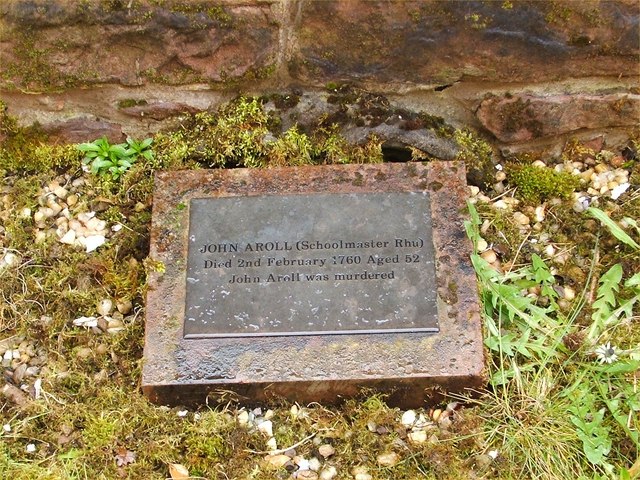Plaque at the site of John Aroll's gravestone
Introduction
The photograph on this page of Plaque at the site of John Aroll's gravestone by Lairich Rig as part of the Geograph project.
The Geograph project started in 2005 with the aim of publishing, organising and preserving representative images for every square kilometre of Great Britain, Ireland and the Isle of Man.
There are currently over 7.5m images from over 14,400 individuals and you can help contribute to the project by visiting https://www.geograph.org.uk

Image: © Lairich Rig Taken: 4 Apr 2009
This plaque is one of several that are located at the foot of a wall alongside a narrow and probably seldom-visited lane (visible on the left, behind a gate, in Image) behind the church halls of Image The plaques indicate the positions of some old gravestones that have been placed, and almost entirely buried, at the foot of the wall; for a discussion of the location, and of the other stones to be found here, see http://www.geograph.org.uk/article/Dumbarton-Cemetery#the-parish-churchyard The text on this plaque is rather terse: "JOHN AROLL (Schoolmaster Rhu) Died 2nd February 1760 Aged 52 John Aroll was murdered." The original stone is also located here, but is largely buried to preserve it. Only its very top can be seen; in this picture, the top of the stone can be seen at the base of the wall, right behind the plaque, partly covered in moss. The other old stones that are set along this wall (click on the end-note title and look for the memorials to John Bell, Captain James Lang, and William McAlla) have likewise been partly buried. The inscription on the original stone cannot be seen, but reads as follows (with original quirks of spelling retained): "Here lyes the body of John Aroll, shoolmaster of Row, who died febuar the 2, 1760. Aged 52 years. Omnibus est Odio, Crudelitas et simulatio Repugnat Amicitie." [The part in Latin means "cruelty is hateful to all, and insincerity is repugnant to friendship". Row is an older spelling of the place-name Rhu (Image). For an illustration of the gravestone, see Donald MacLeod's "Dumbarton Ancient & Modern" (1893).] The story behind the gravestone is recounted by Dr I M M MacPhail in "Dumbarton through the Centuries"; the story can also be found in Donald MacLeod's book, cited above. Aroll had gone to Dumbarton to collect the then very considerable debt of £30 from a man named Cunningham, who, after obtaining a receipt from Aroll, killed him, and took back the money. For a while, Cunningham concealed the body in a disused chimney, but he later threw it into the River Leven under cover of darkness. There was, at the time, a superstitious belief that if a murderer touched his victim's body, then the latter would bleed (this was called "ordeal by touch"). Cunningham was a chief suspect when Aroll's body was found, but, when asked to touch the corpse, he refused, claiming to believe that the corpse would bleed because he (Cunningham) had shaved on a Sunday. In response, the parish minister pointed out that he himself had occasionally shaved on a Sunday, and that he had touched the corpse without causing it to bleed. Nevertheless, Cunningham managed to evade justice for the rest of his life, confessing only on his deathbed.

